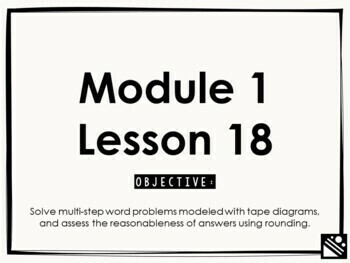Math Presentation for Google Slides™ - 4th Grade Module 1 Lesson 18
Engaging Teacher
641 Followers
Engaging Teacher
641 Followers

Made for Google Drive™
This resource can be used by students on Google Drive or Google Classroom. To access this resource, you’ll need to allow TPT to add it to your Google Drive. See our FAQ and Privacy Policy for more information.
Description
Teach Engage NY Math easily using Google Slides™!
These presentations include slides for each component of the lesson including: Fluency, Application Problem, Concept Development and Student Debrief.
Teaching Engage NY Math using these presentations will:
- Reduce prep time and improves lesson pacing as you don’t have to refer back to the teacher’s manual during the lesson.
- Let anyone follow along. Now, you can feel comfortable leaving the Engage NY Math lesson for substitutes to teach.
- Keep the lesson on track - both you and the students have a visual reminder of what is coming up next in the lesson.
- Help you recover when the lesson goes “off course”.
Adorable “Dot Dudes” theme keeps students engaged throughout the lesson.
Unabridged lessons allow you to teach the curriculum with fidelity.
Editable text gives you the opportunity to customize lessons for your classroom. To secure the clip art I use in my products, the slide backgrounds are not editable.
This product aligns with Engage NY Math, a free program. I am selling my time and creativity in designing supplemental (and engaging) presentations specifically for Google Slides™.
Total Pages
Answer Key
N/A
Teaching Duration
N/A
Report this resource to TPT
Reported resources will be reviewed by our team. Report this resource to let us know if this resource violates TPT’s content guidelines.
Standards
to see state-specific standards (only available in the US).
CCSS4.NBT.A.1
Recognize that in a multi-digit whole number, a digit in one place represents ten times what it represents in the place to its right. For example, recognize that 700 ÷ 70 = 10 by applying concepts of place value and division.
CCSS4.NBT.A.2
Read and write multi-digit whole numbers using base-ten numerals, number names, and expanded form. Compare two multi-digit numbers based on meanings of the digits in each place, using >, =, and < symbols to record the results of comparisons.
CCSS4.NBT.B.4
Fluently add and subtract multi-digit whole numbers using the standard algorithm.
CCSS4.OA.A.3
Solve multistep word problems posed with whole numbers and having whole-number answers using the four operations, including problems in which remainders must be interpreted. Represent these problems using equations with a letter standing for the unknown quantity. Assess the reasonableness of answers using mental computation and estimation strategies including rounding.
CCSSMP3
Construct viable arguments and critique the reasoning of others. Mathematically proficient students understand and use stated assumptions, definitions, and previously established results in constructing arguments. They make conjectures and build a logical progression of statements to explore the truth of their conjectures. They are able to analyze situations by breaking them into cases, and can recognize and use counterexamples. They justify their conclusions, communicate them to others, and respond to the arguments of others. They reason inductively about data, making plausible arguments that take into account the context from which the data arose. Mathematically proficient students are also able to compare the effectiveness of two plausible arguments, distinguish correct logic or reasoning from that which is flawed, and-if there is a flaw in an argument-explain what it is. Elementary students can construct arguments using concrete referents such as objects, drawings, diagrams, and actions. Such arguments can make sense and be correct, even though they are not generalized or made formal until later grades. Later, students learn to determine domains to which an argument applies. Students at all grades can listen or read the arguments of others, decide whether they make sense, and ask useful questions to clarify or improve the arguments.





